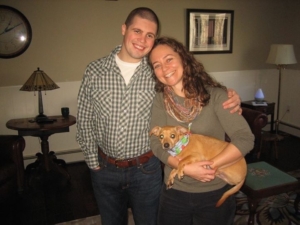When my little brother was a child he would only eat white food. Pasta with butter, chicken fingers, vanilla ice cream, and Entemann’s Pop Em’s (not the chocolate ones) were not only his favorites, but pretty much his entire eating repertoire. Today, he’s open to trying most foods, and has a considerably more varied pallet, but I still assume he’ll only want pasta. It’s funny how the brain works. It can get wired to remember something from years ago, no matter how many times you’ve seen a change. It’s almost like our brain gets stuck in the past. We think we can’t when we can.
Sometimes that can be useful. Matt once got food poisoning after eating chicken with peppers. Twenty years later, he still can’t mix the two in one meal. His brain thinks that’s a toxic mix and he’s now repulsed by the combo. He may have had chicken and peppers every week before things went bad one time. It doesn’t matter. Logic doesn’t trump the brain’s desire to keep us alive and safe. Once a poison, always a poison. His brain now knows chicken and peppers is something he should stay away from.
We’re planning to Hike Mt. Kilimanjaro. I’m nervous. I’ve been in high altitudes before and I suffered. I presume it will be the same situation, but it’s not a guarantee. It’s good that I can prepare better, but the worry can only take me so far. I’ll be sick or I won’t. Similarly, I developed chostocondritis (an inflammation of the soft tissue around your ribcage). At first push-ups seemed to inflame the chosto. I’m still nervous about doing push-ups even though I did them for thirty-four years without problem. Still, I link arm work with aggravating the pain in my ribs. My brain is officially wired to fear them even though statistically they have done me more good than harm. I’ve been trying to retrain my brain by trying less sets of gentler push-ups. It needs to relearn that they won’t always hurt me. But the desire to move cautiously is my brain being wise.
Our brains are fascinating and funny that way. The brain has good intentions, but sometimes it can get the wrong signal or a signal that in this day in age we can rationalize away. The brain getting wired to believe we are in pain may be part of the chronic pain syndrome plaguing our society. If you’re brain thinks you are in pain, you are in pain. I’m not trying to minimalize your pain or say it’s all in your head. If it’s in your head you will feel it in your body. Likewise if it’s in your body it will be your head that lets you know. One of the newer theories on chronic pain is that sometimes our nervous system can get the wires crossed. The brain might get so used to signaling us that we are in pain that even when the body is no longer in pain, the brain continues to tell us we are. It wants to keep us from getting reinjured. But we might be able to teach ourselves the old Apple motto: Think Different.
I feel that I must mention here that I do not believe that we always make ourselves sick and we can just think ourselves out of any situation. I don’t believe if you think differently you can cure your own cancer. I think that is an immoral amount of pressure to put on a person. Our minds can change our perspective, but they can’t cure a slipped disc, melanoma, or dementia. At least, if they can, we haven’t learned how yet. And while the brain is amazing, the body does have a role to play and deserves some of the credit for the good and the bad that happens to us. I’m a lover of life with a couple autoimmune issues. I’d love to will them away, and I’ve learned that when you are sick it’s really easy to blame yourself, but not helpful. Your brain didn’t make you sick. Cut yourself some slack. We can alter our perspective, but we can’t always imagine away what is physically happening in our body.
In addition to help us unravel issues with chronic pain, we can take what we are learning about the brain and relate it to movement. Is there something you struggle with in class—maybe a full push-up or the full roll up (see last week’s blog)? It is physically possible that you currently can’t do this move. But if you keep telling yourself you can’t, that powerful grey matter has a good chance of keeping you from ever doing it. Instead, how can you alter your behavior to retrain the brain to learn you can? Just because you haven’t been able to in the past does not mean you never will in the future. My brother eats hot sauce now. You can breakdown the movement into pieces you can currently conquer and focus on that as a success. With practice you can build up slowly. You can start telling yourself you can, even if right now you can’t. Basically, instead of “I can’t,” consider “I think I can,” or “I’m getting there.”
I try this technique with sleep. I’m a terrible sleeper, but once in a while I attempt positive talk therapy. It makes me laugh, but I literally tell myself I’m the best sleeper in the world. I’m an award winning sleeper. I’m going to sleep deeper and better than anyone else in the world tonight. It works, sometimes. It’s kind of like the placebo effect. It tends to work for a little while.
Our body and mind do work in conjunction, but sometimes our brains can hold us back. We need to evaluate each instance on its own, but in the case of most movement, presuming we don’t have an actual injury, it’s time to stop letting our mind get in the way of our future potential.
Want more Personal Euphoria?
Follow the Personal Euphoria Facebook page, follow Personal Euphoria on Instagram, and subscribe to the Personal Euphoria YouTube Channel.

